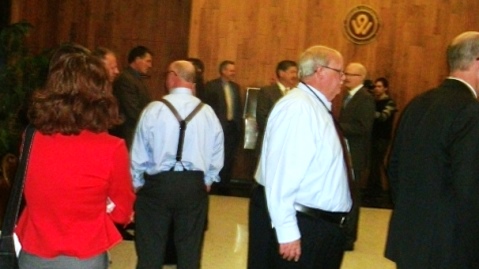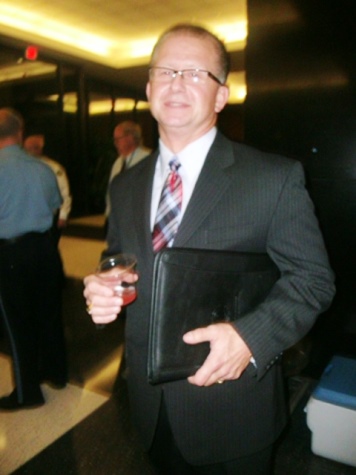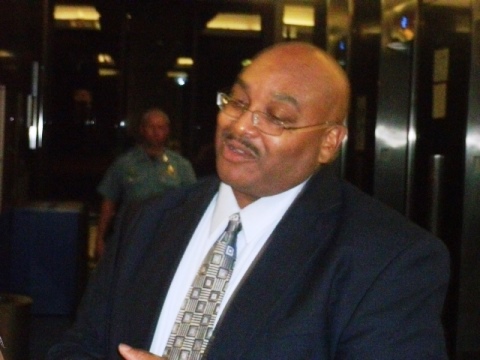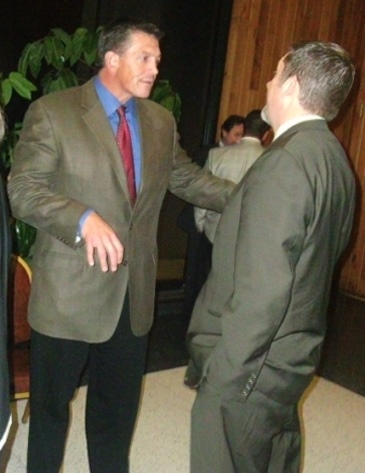Window on the West
by Mary Rupert
Low voter turnout in Wyandotte County played a role in the general election Tuesday, but not as big of a role that it would have made much difference in the election’s outcome for the major races, according to political observers.
Tuesday’s big surprises to political observers were Gov. Sam Brownback’s re-election by 4 percentage points and Sen. Pat Roberts’ win by 10 percentage points, according to Patrick Miller, assistant professor of political science at the University of Kansas, Lawrence. Observers had thought that the governor’s contest would be close, and Gov. Sam Brownback won re-election in a fairly close contest.
Their re-election was more about how Republicans who said they were unhappy with Republican candidates actually voted than it was about the Democratic vote, Miller believes.
About 30 percent of Republicans told pollsters in advance they were not going to vote for Brownback or Roberts. But on Election Day, 15 percent of these voted for Greg Orman, the independent Senate candidate, and 20 percent voted for Paul Davis, the Democratic candidate for governor, Miller said. A third to a half of the Republicans who had said earlier they would defect from the party candidate actually voted for the party candidate, Miller said.
“Something happened to Republican voters at the last minute” to change their minds, he said.
He believes that first, Republicans had a good “get-out-the-vote” program. Davis and Orman did well in the early vote, and Democrats had the enthusiasm to vote early, but Davis and Orman did much worse on Election Day, he said. That points to a good GOP “get-out-the-vote” program.
It’s also possible that a lot were tempted to break away, and in the end came back to their party in an anti-Obama sentiment, he said. Pollsters know that these swing voters did not like Roberts and also did not like Obama, he added.
“Maybe in the end, they couldn’t actually bring themselves to vote against them,” Miller said.
‘The polls weren’t wrong’
Miller maintained that polling was accurate. “They were accurate in everything except in what percentage of Republicans would actually break away from their party. They were accurate on the independent and Democratic vote.”
Everything remained the same in the early and the exit polls – Obama approval, tax cuts, opinions about Roberts – except one thing, the percentage of Republicans breaking away from their party.
It’s easy to say the polls were wrong, he said, “but clearly something happened at the end.” That could be the “get-out-the-vote” effort, he added.
In the exit polls, after voters had cast ballots, they were asked if Roberts spent enough time in Kansas, and 63 percent responded no, the same as they had said all along, he said.
“It looks like a good chunk of voters do not like Brownback or Roberts’ policy, but held their noses and voted for them in the end, either because they were Republican, or they were sending Obama a message,” Miller said.
The downside for the Democrats is obviously that they lost, and the positive for them is that Brownback’s job approval now is about negative 20, he said. His disapproval rate is about 20 points higher than his approval, and he is the most unpopular governor to be re-elected in the United States in decades, according to Miller.
If Brownback continues to be unpopular, that can come back to bite the Republicans in two to four years, he said.
Republican leaders in Kansas have made statements after the election that do not recognize any discontent and have said they will stay the course. Miller views that as a danger for the Republicans, given the level of discontent shown in the polls.
For the Democrats, who lost, their challenge is to turn the loss and the unpopularity of the Republicans and tax cut plan to their advantage, to translate it into a win in two years in the state Legislature, he said.
It cuts both ways for the parties, and neither party should read too much into the election results, he added.
Election was ‘more about Obama’
“Kansas made history this year in the election process,” said Rep. Tom Burroughs, House assistant minority leader from the 33rd District in Wyandotte County. “We had quality candidates at the top of the ticket all the way down through the legislative races, and it motivated everyone’s base to get out and vote.”
“I believe that the Senate race and the governor’s race was really more about Obama than it was about the real issues and challenges facing Kansas,” Rep. Burroughs said. “I think the voters were saying that they’re hoping that gridlock will cease, that Washington will begin to work together, and that Kansas values do matter. I, like many, hope that this has sent a message, and the candidates have received a message that they are looking for solutions, they are looking for policies to provide jobs and opportunity. First, and foremost, we may be D’s and R’s, but we’re all Kansans.”
Rep. Burroughs noted that the governor’s race was very close. “Some will take that as a referendum in support of his policies, others will take it as a dissatisfaction with the administration,” he said. “It sends a signal to many of us that this state is heavily divided, and we shouldn’t be R’s and D’s, we should be Kansans first. We should all be very concerned over the next couple of years. We have a lot of challenges ahead of us. As the assistant leader of our caucus, we stand ready to work on those policies that will assist in moving Kansas forward. We stand ready to help craft policies that are mindful that all Kansans deserve quality education, deserve opportunity, and deserve to be respected.”
Kansas is a red state
“This is Kansas, and we’re considered a red state,” said Wyandotte County GOP chairman Mark Gilstrap.
There were a lot of different polls and comments during the campaign, but at the end of the day, the Republicans have an extremely large amount of voters in Kansas, he said.
“I don’t really pay a lot of attention to the polls,” Gilstrap said. He’s wondering if the polls got an accurate representation of the voters in this election.
While people thought the Republican Party was split, it appears to be a small group of disgruntled Republicans, Gilstrap said. At the end of the day, Johnson County, which is known for its support of public education, supported Brownback.
“If they’re upset with Sam Brownback, I’m sure they would have voted him out, but they endorsed him on election night,” Gilstrap said.
While the statewide offices are basically the same, in the state Legislature, Republicans picked up several seats in the House of Representatives, he said.
There was no change in the state representatives in Wyandotte County, although Republican Sue Adams came within about 150 votes of winning the 33rd District seat, which is represented by Rep. Burroughs, a Democrat. After redistricting, the 33rd District picked up more territory in the Edwardsville and Bonner Springs area, where there are a larger number of Republicans in the district than in the past.
Rep. Burroughs, who will be a candidate for House minority leader when the Democratic caucus meets Dec. 1, said that his opponent was successful in getting out the vote and being part of the base that was turned out by the governor’s race and the Roberts race. Voters re-elected Rep. Burroughs, 59, who was first elected in 1997 and has the reputation of being a consensus builder who can work in a bipartisan manner.
“I am absolutely honored and pleased to represent the 33rd District,” Rep. Burroughs said, ”to continue to do it in the manner I have in the past, respectfully and unselfishly. I want to thank my constituents in the 33rd District for again putting their trust, faith and support in my re-election.”
Wyandotte County’s low voter turnout
In Wyandotte County the big story was the low voter turnout, with everyone expecting a larger number of voters at the polls. Only about 35 percent of the registered voters here cast a ballot, compared to 40 percent in other recent midterm elections.
“It’s something that disappointed the Democrats yesterday [Tuesday] and the Republicans were happy to see,” Miller said. “Wyandotte voters were not as engaged as the rest of Kansas with the election.”
However, Miller said he does not think a large Wyandotte County turnout would have changed the outcome of the election at all, including the governor’s race, although it would have made it a lot closer.
With a lower income level than the rest of the state, a larger working class, more minority voters, and lower college education levels, he said, Wyandotte County fits into the profile of areas that have lower turnout.
Strong predictors of high voter turnout are white, wealthy and high levels of education – like Johnson County, which usually votes at a higher rate than the rest of the state, Miller said.
In Wyandotte County, there were enough Republican voters who turned out to make some of the contests interesting this year.
“The national races encouraged the base to get out in a manner that we haven’t seen in a while in Wyandotte County, and I compliment them on that,” Rep. Burroughs said.
“These were important elections all the way down the ticket,” Rep. Burroughs said. “Those that didn’t participate in this process shied away from their responsibilities. And those responsibilities are to ensure that your values, your comments and concerns, are validated through your vote or by being part of the process.”
Gilstrap said that although the election commissioner anticipated a 40 percent turnout in Wyandotte County, the same as the last midterm election, Gilstrap personally had predicted voter turnout here would be 38 percent. It was closer to 35 percent.
He said one of the reasons for a low turnout here was that it was a midterm election without a highly charismatic candidate such as Barack Obama on the ballot. Second, there was not a Democrat running for the U.S. Senate. Gilstrap said many Wyandotte County voters will go to the polls and vote Democratic, but with Orman running as an independent, it did not motivate them.
Even though the Democrats worked hard, no one in Wyandotte County really knew who Paul Davis was, Gilstrap said. Davis, the House minority leader, represented Lawrence, Kan., in the state House. Davis did visit Wyandotte County during the campaign, appearing, among other places, at a parade in the Quindaro area and at a local restaurant.
“I saw Sam Brownback in Wyandotte County much more than I saw Paul Davis in Wyandotte County,” Gilstrap said.
Looking at voter turnout, there were Republican candidates opposing Democratic state representatives on the west side of Wyandotte County, but not on the east side of Wyandotte County. Did the presence of opposition cause the local campaigners to work harder on the west side, where there was opposition, and also where there is a larger number of Republican and nonaffiliated voters, while they didn’t campaign as hard on the east side of the county?
While it is correct that candidates tend to work harder when they have an opponent, Gilstrap said that there was no plan or intention to file candidates on one side of town or the other. It just happened that way. At the local county level, they’re so small they’re just thankful if anybody at all wants to run for office, he said.
U.S. representative, 3rd District contest
Miller said the contest for U.S. representative, 3rd District, between incumbent Rep. Kevin Yoder, a Republican, and Kelly Kultala, a Democrat, was the closest House race in the state at 60 percent to 40 percent.
“Clearly Yoder succeeded in getting a lot of Davis and Orman supporters to support him. He did better than Brownback and Roberts in the district,” Miller said.
He pointed out that in House races nowadays, the base amount of money needed to be competitive is $1 million, and Kultala had only about $300,000 to spend. She did have some name recognition and had served in office before, which helped.
The two candidates did not debate or appear together at a forum, an indication that the incumbent may have felt fairly confident in his lead. At the end of the campaign, some negative mailers about Kultala were sent out, indicating someone may have been a little worried about Orman and Davis doing well in the 3rd District, he added.
Not particularly a high-profile Congressman, Yoder has put together an image that fits the district well, he said. Given the right circumstances, he could be vulnerable. His biggest challenge is the primary where some Republicans may not perceive him as conservative enough, he said.
It was a status quo election, where mostly incumbents won, some of whom are unpopular and have unpopular policies. If the winners don’t work on that, it could come back in a few years to haunt them, Miller said.
To reach Mary Rupert, editor, email maryr@wyandottepublishing.com.




